The following Helpdesk publications provide a range of expert-written guides that assist businesses in understanding the IP landscape in South-East Asia.
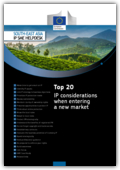
|
Top 20 IP considerations when entering a new market
Global markets are an important source of growth for small and medium-sized enterprises (SMEs). Increasing the internationalisation of SMEs and helping them access third markets is crucial for Europe’s competitiveness, economic growth, and innovation. The European Commission’s (EC) priority is to ensure that enterprises can rely on a business-friendly environment and make the most out of growth markets outside the European Union (EU).
|

|
Guide to patent protection in South-East Asia
A patent is an exclusive right granted for the protection of new inventions, which are products or processes offering new technical solutions or providing new ways of doing something. The product or process in question must be capable of industrial application. To qualify for patent protection, inventors or owners must file a patent application as registration is required to obtain protection for a patent. Patent protection lasts for a limited time, usually 20 years. In return for this legal monopoly of limited duration, the owner of a patent must disclose the invention to the public. A patent is a territorial right and has its effects only within the national boundaries of the country for which it is granted.
|
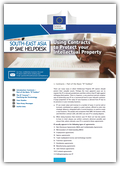
|
Using contracts to protect your intellectual property There are many ways in which Intellectual Property (IP) owners should protect their valuable assets. Perhaps the most apparent ways are to register the IP in relevant jurisdictions and then enforce that IP right against infringing third parties. There is, however, a very practical and pre-emptive way of protecting your IP on a commercial level in your relevant contracts. A large proportion of the value of your business is derived from IP due to its presence in your everyday business. PDF 978-92-9460-674-7 10.2826/391907 EA-09-21-188-EN-N |
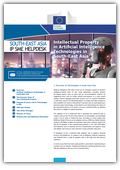
|
Intellectual Property in Artificial Intelligence technologies in South-East Asia Artificial intelligence (AI) refers to the use of computer systems to perform intelligence-based tasks. AI has many applications including systems for playing games such as chess and go; recommendation systems for suggesting items such as media content and products to a user; search engines; natural language processing systems such as machine translators or chat-bots; systems for identifying objects in images and video sequences; and controllers for systems that perform functions such as load balancing in electricity grids. PDF 978-92-9460-974-8 10.2826/163220 EA-06-21-182-EN-N |
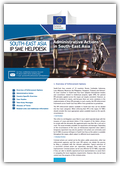
|
Administrative Actions in South-East Asia South-East Asia consists of 10 countries: Brunei, Cambodia, Indonesia, Laos, Malaysia, Myanmar, the Philippines, Singapore, Thailand, and Vietnam. As most countries in South-East Asia have adopted international treaties and conventions related to intellectual property rights (IPR), the general IPR principles applied across the region are largely consistent. However, as IPR are territorial in nature, and because there are some variations in the implementation of these IPR principles in each country, the IPR enforcement framework across South-East Asia differs from jurisdiction to jurisdiction. The IPR enforcement options available in South-East Asia can be divided into five main categories. When enforcing their IPR in the region, EU SMEs should consider the most appropriate option available based on the specific circumstances. PDF 978-92-9460-976-2 10.2826/387504 EA-09-21-513-EN-N |
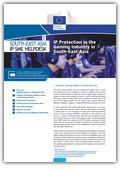
|
IP protection in the gaming industry in South-East Asia The term ‘smart city’ describes a framework, predominantly composed of information and communication technologies (ICT), that seeks to gather and organise data from multiple sources to enable the more efficient and sustainable management of an urban area. PDF 978-92-9460-972-4 10.2826/923501 EA-05-21-331-EN-N |
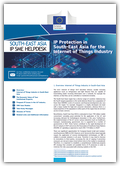
|
IP protection in South-East Asia for the Internet of things industry There are significant opportunities for European-based small and medium-sized businesses (SMEs) in SEA. However, as IoT devices by their nature typically require the application of several interdependent technologies, an SME is unlikely to provide solutions in all areas. Therefore it may need to disclose its innovations to third parties, increasing the risk of copying if preventive measures are not put in place (even before entry to the market is considered). Therefore, it is important to establish a comprehensive intellectual property (IP) strategy that considers all available forms of IP protection in order to minimise the risks associated with entering markets in the SEA. PDF 978-92-9460-115-5 10.2826/550211 EA-02-20-578-EN-N |
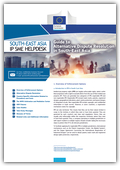
|
IP protection in South-East Asia for the smart cities industry The term ‘smart city’ describes a framework, predominantly composed of information and communication technologies (ICT), that seeks to gather and organise data from multiple sources to enable the more efficient and sustainable management of an urban area. PDF 978-92-9460-029-5 10.2826/499446 EA-04-20-350-EN-N |

|
Guide to alternative dispute resolution in South-East Asia Intellectual property rights (IPR) are legally enforceable rights, which confer their proprietors with a right to exclude others from the use of their intellectual property (IP). There are generally two categories of IPR, registrable IPR and non-registrable IPR. PDF 978-92-9460-708-9 10.2826/389198 EA-02-21-729-EN-N |
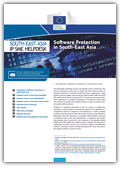
|
Software protection in South-East Asia The Information Technology services and software sector in South-East Asia has been booming in recent years as South-East Asian nations continue to develop and flourish. In particular, South-East Asia is experiencing a rapid growth of Internet, digital, social media and mobile activities. PDF 978-92-9460-699-0 10.2826/773231 EA-05-21-161-EN-N Paper 978-92-9460-700-3 10.2826/558646 EA-05-21-161-EN-C |
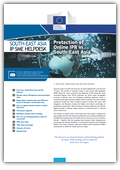
|
Protection of online IPR in South-East Asia Internet usage in South-East Asia has increased significantly over the past 10 years. The number of “netizens” varies in each country with Singapore (82%) being the most connected and Myanmar (2.1%) being the least connected (figures from 2014). Estimates for 2016 report remarkable increase in internet users for Cambodia, Indonesia, Myanmar which is consistent with rapid economic growth in these countries. The same ranking among the South-East Asian countries however remains the same, with Singapore and Myanmar having the highest and lowest percentage of penetration respectively. PDF 978-92-9460-318-0 10.2826/53191 EA-01-20-752-EN-N Paper 978-92-9460-319-7 10.2826/00013 EA-01-20-752-EN-C |
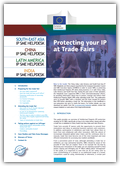
|
Protecting your IP at trade fairs internationally This guide provides an overview of Intellectual Property (IP) protection strategy for EU SMEs specifically on how to be ready before, during and after a trade fair or exhibition in China, South-East Asia and Latin-America. Trade fairs provide IP owners with the opportunity to present their innovations and ideas to potential business partners and customers. In addition, participation in exhibitions and trade fairs allows them to learn from and collaborate with other innovators. PDF 978-92-9460-259-6 10.2826/635413 EA-02-20-862-EN-N Paper 978-92-9460-260-2 10.2826/443116 EA-02-20-862-EN-C |
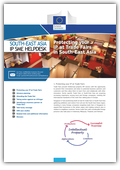
|
Protecting your IP at trade fairs in SEA Trade fairs provide intellectual property (IP) owners with the opportunity to present their innovations and ideas to potential business partners and customers and they allow them to learn from and collaborate with other innovators. Sector specific Trade Fairs in South-East Asia are acquiring increasing importance among local and foreign companies, meeting the international standards of the main fairs taking place in Europe. PDF 978-92-9460-313-5 10.2826/856518 EA-01-20-749-EN-N Paper 978-92-9460-312-8 10.2826/044744 EA-01-20-749-EN-C |
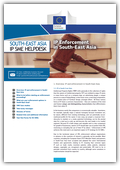
|
IPR enforcement in South-East Asia Intellectual Property Rights (“IPR”) refer generally to the collection of rights that the owners of intellectual property (“IP”) are entitled to enjoy. IP exists in many forms such as a company logo, an advertising slogan, a unique process or a way of doing things, a new music score, a new drug composition, or a creative piece of furniture design, amongst others. All these various forms of IP share a common characteristic – they are creations of the mind and feature unique and distinguishing characteristics that differentiates them from other IP. In the business world, this uniqueness is economically valuable. Inventions, for example, typically enjoy a natural monopoly because inventions are, by nature, different from existing technology, and can potentially secure newfound profits for the owner. A new song can propel a musician from obscurity to stardom or a newly patented technology can be the pivotal step for a start-up to scale up and become the next leader in its market segment. Because IP is both unique and valuable and is a key component for growth of businesses, owners of IP should take care to protect their IPR, restricting or excluding the use of their IP by others. Enforcement of IPR achieves this need and is an important aspect of IP strategy for EU SMEs. PDF 978-92-9460-337-1 10.2826/688354 EA-04-20-687-EN-N Paper 978-92-9460-336-4 10.2826/948690 EA-04-20-687-EN-C |
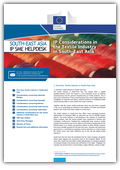
|
IP considerations in the textile industry in South-East Asia The textile industry in South-East Asia offers many promising business opportunities to European SMEs, as garments are one of ASEAN’s largest exports. The textile industry is still growing in the majority of South-East Asian countries, with the fastest growth rates registered in Vietnam and Cambodia. Furthermore, Thailand has traditionally been strong in textile manufacturing and has now set its sights on becoming a fashion hub for the ASEAN region as its textile and garment exports to other ASEAN countries have been steadily growing for the past few years. Similarly, the Indonesian government is committed to preparing several incentives in a bid to boost the textile sector and make Indonesia one of the top five global textile exporters. South-East Asia has been the production hub for many European companies which export apparel and accessories back to the European Market. At the same time, South-East Asia offers market opportunities for European products as European design is becoming more well-known in the region. Singapore, for example, has become Asia’s second fashion capital, offering a variety of high-end international brands. As Asian consumers are becoming more affluent and cities like Bangkok or Kuala Lumpur are more established in the fashion world, opportunities for European SMEs in the region will grow. PDF 978-92-9460-326-5 10.2826/696319 EA-04-20-682-EN-N Paper 978-92-9460-327-2 10.2826/641641 EA-04-20-682-EN-C |
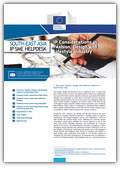
|
IP considerations in fashion, design and lifestyle industry The fashion, design and lifestyle sector is a significant driver in South-East Asia’s (SEA) creative economy. The global fashion industry has traditionally been one of the most lucrative industries, with sales generated in the trillions globally. This is especially so in SEA, where it has been seen that consumers gravitate towards fashion and do not shy away from paying top dollar for luxury fashion products. Singapore, for instance, holds a 2% share of the world apparel market and their fashion industry generates sales of USD3.6 billion1(approx. EUR3.1 billion). In Indonesia, it contributed about USD49.3 trillion (approx. EUR42.8 trillion) to the GDP, with the fashion industry alone accounting for 28% of total earnings in the creative economy2. Among the SEA countries, the design and lifestyle industry has been pegged as emerging industries especially in Singapore where, an ad hoc organization, the Design Singapore Council, was established in 2003 to help develop the nation’s design sector, following the Economic Review Committee’s report which identified the creative industry as one of the three new sectors (including education and healthcare) for economic growth of the country. The Design Business Chamber in Singapore, a multidisciplinary design chamber also administers design certifications such as the Singapore Good Design Certification and awards such as the Singapore Design Awards and Singapore Good Design to recognize and enhance a good design’s value proposition. PDF 978-92-9460-308-1 10.2826/22949 EA-01-20-747-EN-N Paper 978-92-9460-309-8 10.2826/75596 EA-01-20-747-EN-C |
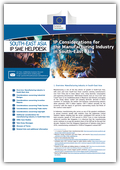
|
IP considerations for the manufacturing industry in South-East Asia Manufacturing is one of the key drivers of growth in South-East Asia, with more and more South-East Asian countries winning manufacturers over from China due to lower labour costs, rising domestic consumption and improving infrastructure. Well-known brands such as Coca-Cola and Coach have so far established plants in Myanmar and Vietnam, leveraging on the cheap labour market and growing domestic demand in these countries. In Cambodia, the textiles and footwear manufacturing industry alone generates USD 6 billion (approx. EUR 5 billion) annually for the economy, with the export of garments representing nearly two-thirds of the country’s total export. In Indonesia, manufacturing also serves as one of the greatest contributors to annual economic growth with statistics from the Indonesian Central Statistics Agency showing that the sector contributed 0.92 percent to the total economic growth of 5.02 percent in 2016. Even in more technically advanced countries like Singapore, it is observed that the manufacturing sector continues to occupy the greatest share of the GDP pie for the past few decades. Statistics from the Singapore Department of Statistics show that in 2016, manufacturing contributed to 19.6% of Singapore’s annual GDP. PDF 978-92-9460-299-2 10.2826/86638 EA-03-20-824-EN-N Paper 978-92-9460-298-5 10.2826/27733 EA-03-20-824-EN-C |
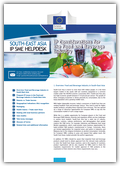
|
IP considerations for the food and beverage industry South-East Asia is home to more than 600 million people. It is the third largest market in the world, with ten countries integrated in a common market under the ASEAN Economic Community (AEC). South-East Asia also has high economic growth between 3-10 percent per annum. The growth of these emerging economies is driven primarily by consumption, due to the large population and a growing middle-class. With higher disposable incomes, today’s consumers in South-East Asia are seeking healthier food and beverage choices. They tend to look for higher quality products, including those imported from overseas. This has opened up a range of attractive opportunities for European SMEs to tap into the consumption market of such a large region. While this is a golden opportunity for European players in the Food and Beverage (F&B) industry, diversity and regulatory affairs are key challenges in various local markets. South-East Asia has a wide mix of cultures, religions, customs, culinary preferences, and demographics that greatly impacts the F&B sector. For example, Indonesia and Malaysia have large Muslim populations, which could provide many business opportunities for halal-certified F&B products manufactured in Europe. Conversely, there are limited opportunities for imported wines and spirits in Indonesia and Malaysia due to the religious limitations on alcohol consumption. Generally, for European SMEs seeking to grow and expand their global reach, the South-East Asian market provides the perfect opportunity. PDF 978-92-9460-329-6 10.2826/389488 EA-04-20-683-EN-N Paper 978-92-9460-328-9 10.2826/38208 EA-04-20-683-EN-C |

|
IP considerations for the creative industries in South-East Asia The development of creative industries in various South-East Asian countries is incredibly varied. This is evident from the 2014 WIPO Studies on the Economic Contribution of the Copyright Industries, which compared the significance of copyright industries among several countries worldwide. The comparison study is highly relevant as copyright-intensive industries, being industries dependent on the protection of copyright and related rights are the main and substantive constituents of the creative industries. This study revealed that the contribution of copyright-intensive industries to Gross Domestic Product (”GDP”) was the lowest in Brunei among the South-East Asian countries, at 1.58%3 , while in Singapore the copyright intensive industries had an above average4 contribution of 6.19%5 . As for the contribution of copyright-intensive industries to national employment, the Philippines ranked the highest worldwide (not just in South-East Asia) with a percentage contribution of 11.10%6 , while in Thailand the contribution was as low as 2.85%7. It is therefore arguably clear that the development level of the creative industries, or at least the copyright-intensive industries, is presently not homogenous across South-East Asia. PDF 978-92-9460-294-7 10.2826/083346 EA-06-20-092-EN-N Paper 978-92-9460-295-4 10.2826/119615 EA-06-20-092-EN-C |
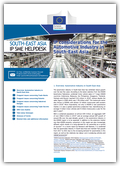
|
IP considerations for the automotive industry in South-East Asia The automotive industry in South-East Asia has exhibited robust growth over the last few years. According to the latest statistics from the ASEAN Automotive Federation, combined motor vehicle sales in 7 major ASEAN countries (Indonesia, Malaysia, the Philippines, Singapore, Thailand, Vietnam and Brunei) reached 3.16 million in 2016 , almost double the sales figure in 2006 which was 1.78 million units . The motorcycle sector also thrives in ASEAN, with almost 10 million motorcycles and scooters sold in 2016. More importantly, not only is ASEAN a vast automotive market, it is also a global automotive production hub, manufacturing on average 4 million motor vehicles and 9 million motorcycles a year for the past 5 years . With a combined population of almost 630 million, an aggregate GDP of over US PDF 978-92-9460-303-6 10.2826/349641 EA-03-20-825-EN-N Paper 978-92-9460-302-9 10.2826/962553 EA-03-20-825-EN-C |

|
IP audit check-list An increasing number of small and medium-sized enterprises (SMEs) are realising the importance of intellectual property (IP) as a key economic asset in their overall business activity. Strong IP and a robust IP strategy can enable a company, of any size, to survive economic downturns as well as to grow sustainably during the boom period. All companies own intangible assets. However, sometimes they may not recognise their own IP and especially the potential value of it for various reasons. For instance, they might not be trained to do so. This simple ‘self audit kit’ aims to make European SMEs aware of the IP they already hold and how it can be economically advantageous for them. Intangible assets can and should be protected since they contribute to increased productivity, build an image of a company, give it a competitive edge and influence the valuation of an enterprise. PDF 978-92-9460-334-0 10.2826/514691 EA-04-20-686-EN-N Paper 978-92-9460-335-7 10.2826/585262 EA-04-20-686-EN-C |
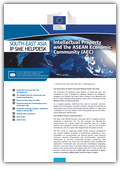
|
Intellectual property and the ASEAN Economic Community (AEC) The goal of the ASEAN Economic Community (AEC) is regional economic integration in South-East Asia. The AEC envisages the following key characteristics: (a) a single market and production base, (b) a highly dynamic and competitive economic region, (c) a region of fair economic development, and (d) a region fully integrated into the global economy. The AEC’s areas of cooperation include human resources development and capacity building; recognition of professional qualifications; closer consultation on macroeconomic and financial policies; trade financing measures; enhanced infrastructure and communications connectivity; development of electronic transactions through e-South-East Asia (agreement between the South-East Asia Member States regarding the application of information and communication technologies); integrating industries across the region to promote regional sourcing; and enhancing private sector involvement for the building of the AEC. In short, the AEC will transform South-East Asia into a region with free movement of goods, services, investment, skilled labour, and freer flow of capital. PDF 978-92-9460-307-4 10.2826/373240 EA-06-20-094-EN-N Paper 978-92-9460-306-7 10.2826/462073 EA-06-20-094-EN-C |
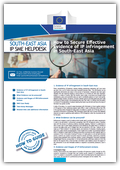 |
How to secure effective evidence of IP infringement in South-East Asia PDF 978-92-9460-354-8 10.2826/03872 EA-06-20-101-EN-N Paper 978-92-9460-355-5 10.2826/498548 EA-06-20-101-EN-C |
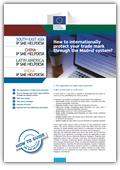
|
How to internationally protect your trade mark through the Madrid system? The ‘Madrid system for the international registration of trade marks’ is a cost-effective solution for registering trade marks worldwide. The system is administered by the International Bureau of the WIPO and allows trade mark owners to protect their marks in several countries by filing one application and obtaining an international registration that takes effect in each of the designated contracting parties. The Madrid system also allows Subsequent Designations to be made, and new territories to be added to an international registration that has already been granted. The system cannot be used to protect a trade mark in countries/regions that are not the members of the Madrid Union. PDF 978-92-9460-006-6 10.2826/628862 EA-02-20-448-EN-N Paper 978-92-9460-007-3 10.2826/440192 EA-02-20-448-EN-C |
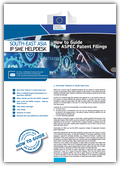
|
How to guide for ASPEC patent filings Patents are a common type of intellectual property that are relevant to various industries, not only for technology intense industry, patents are also present in the medical device and healthcare industries, green industries, machineries, food processing, textile and smart cities to provide few examples. A patent is an exclusive legal right granted to the applicant for a new invention which may be a product or process offering new technical solutions or providing new ways of doing something. It gives the patent owner the right to prevent others from using the patented invention for a limited length of time and it is a main legal tool for preventing innovations from being copied. PDF 978-92-9460-695-2 10.2826/937131 EA-05-21-159-EN-N |

|
Trade secrets protection in South-East Asia Trade secrets are a highly valuable and useful form of intellectual property right (IP). According to the World Intellectual Property Organization (WIPO), any confidential business information (for example sales methods, distribution methods, consumer profiles, advertising strategies, lists of suppliers and clients, manufacturing processes, etc.) which can be of considerable commercial value to businesses and which provides an enterprise with a competitive edge, may be considered a trade secret. PDF 978-92-9460-664-8 10.2826/978474 EA-05-21-143-EN-N |

|
Industrial designs protection in South-East Asia As an European SME doing business in South-East Asia, protecting your intellectual property rights (IPR) in these markets is essential to business success. An industrial design right, also known as a design patent in certain jurisdictions, is an exclusive right, which protects designs which confer a competitive edge to the owner over his competitors due to their aesthetic appeal. PDF 978-92-9460-663-1 10.2826/564299 EA-03-21-239-EN-N |

|
Guide to copyright protection in South-East Asia Copyright is an intellectual property right (IPR), which entitles the owners of literary and artistic works to a set of exclusive rights over their works. These rights include copying, translating, adapting and altering, communicating and performing to the public, distributing, renting and lending copies of the copyrighted works. Copyrights protect intellectual creations expressed in an original form and which are as a result of a creative effort on the part of the author. PDF 978-92-9460-666-2 10.2826/573201 EA-09-21-179-EN-N |
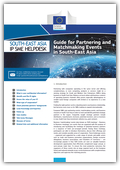
|
Guide for research & development (R&D) activities in South-East Asia In recent years, the R&D industry in South-East Asia has been flourishing, with countries in the region investing heavily to promote R&D activities. PDF 978-92-9460-351-7 10.2826/410295 EA-06-20-100-EN-N |

|
Guide for partnering and matchmaking events in South-East Asia Partnering with companies operating in the same sector and offering complementary, or even competing, products or services might be a winning strategy for Small and Medium Size Enterprises (SMEs) doing business in South-East Asia. Reliance on local culture and business customs of operating business channels often proves especially advantageous to smaller-sized foreign companies with limited or no experience in a new market. Finding the right partner can be a daunting task in any business relationship, but becomes even more so for SMEs looking to expand internationally. PDF 978-92-9460-315-9 10.2826/809521 EA-01-20-750-EN-N |

|
Finding the Right Lawyer Hiring a lawyer is an important decision that should not be based solely upon advertisements or recommendations. An experienced and capable lawyer could not only strengthen your business’s IPR strategy but also effectively assist you in enforcing your IPR rights against infringers. To find a lawyer that can help you with your IPR in the ASEAN region, you should consider contacting the lawyer’s association in your country, the directory of lawyers maintained by your country’s embassy or chamber of commerce in the relevant South-East Asian country, or an online law firm directory.Be sure to gather information and establish the facts about the problem before discussing with a lawyer. This will allow the lawyer to put the problem in context with the local laws and regulations. PDF 978-92-9460-305-0 10.2826/552209 EA-03-20-826-EN-N |
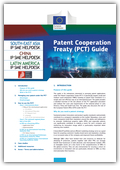
|
Patent Cooperation Treaty (PCT) The South-East Asia IPR SME Helpdesk provides free information and services in the form of jargon-free first-line confidential advice on intellectual property and related issues, plus training materials and online resources. The Helpdesk raises awareness about IPR matters in South-East Asia affecting European SMEs, and helps them make informed IPR decisions. PDF 978-92-9460-382-1 10.2826/629660 EA-04-20-534-EN-N This guide is for enterprises interested in pursuing patent applications under the Patent Cooperation Treaty (PCT). It specifically targets small and medium sized enterprises (SMEs) wanting to patent their inventions in a simple and cost-effective way at an international level. The guide provides a detailed overview of the two phases of the PCT application procedure and outlines the costs and requirements of the national phase in Latin America, China and South-East Asia. The guide also discusses the role of the European Patent Office (EPO) under the PCT. |
 |
Free South-East Asia IPR advice for European SMEs The South-East Asia IPR SME Helpdesk provides free information and services in the form of jargon-free first-line confidential advice on intellectual property and related issues, plus training materials and online resources. The Helpdesk raises awareness about IPR matters in South-East Asia affecting European SMEs, and helps them make informed IPR decisions. PDF 978-92-9202-421-5 10.2826/20344 EA-04-19-155-EN-N Paper 978-92-9202-422-2 10.2826/909762 EA-04-19-155-EN-C |
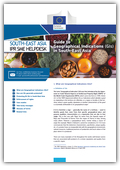 |
Guide to Geographical Indications (GIs) in South-East Asia Geographical Indications (GIs) names have a reputation that inspire trust and are recognised by traders and consumers, who are ready to pay a higher price for them. The link to the place of origin comes from the products’ histories, the impact of the geographical environment on production and processing conditions and/ or the specific know-how used in the different stages of production. In the European market, the GI protection provides many benefits, including high-quality production systems that in many cases use transparent and sustainable production practices and provide better economic gains, a better distribution of profits, and a competitive advantage in the market, a strengthened brand, and greater export opportunities. PDF 978-92-9202-858-9 10.2826/51916 EA-01-20-199-EN-N Paper 978-92-9202-859-6 10.2826/643589 EA-01-20-199-EN-C |
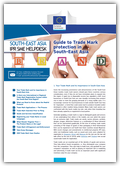 |
Guide to trade mark protection in South-East Asia Given the increasing prominence and attractiveness of the South-East Asian market, trade mark owners should give these countries serious consideration, even if they do not have immediate plans to expand into the region. A rapid rise in disposable income has signalled a shift: local businesses in South-East Asia are now steadily increasing their product mix in order to meet the growing demands of a rising middle class. It is increasingly common for local businesses to look outside South-East Asia for ‘inspiration’, a trend that could easily lead to products branded and/or developed in other markets being imitated. Many trade mark owners are confronted with this harsh reality too late: only when their branding has been already copied by or registered to local parties. Generally speaking, a trade mark is a sign to distinguish goods and services of one undertaking from others in the market, one over which the owner has an exclusive right. Trade marks are words, names, phrases, symbols, designs, images, distinctive features or a combination of these elements that can be represented graphically. At the time of writing, trade marks consisting of the shape of goods or their packaging in three-dimensional form can be registered in all South-East Asian countries except Myanmar. With recent changes and amendments to intellectual property (IP) laws, other non-traditional marks, such as sound and scent, were adopted for registration in Singapore, Brunei and Malaysia (in the last one the law will take effect by the end of 2019), while Indonesia and Thailand now accept sound trade marks for registration. PDF 978-92-9202-792-6 10.2826/413400 EA-02-20-035-EN-N Paper 978-92-9202-793-3 10.2826/729039 EA-02-20-035-EN-C |
|
How to remove counterfeit goods from e-commerce sites in South-East Asia A growing middle class coupled with increasing internet access has led to fast-paced e-commerce growth in South-East Asia (SEA) in the past decades. The middle class population of ASEAN, according to expert estimates, may grow from 190 million in 2012 to 400 million in 20202. Additionally, there are approximately 200 million people in South-East Asia with access to the internet and this number is expected to grow three-fold by 2025. As a matter of fact, e-commerce sales in the region are expected to increase from USD5.5 billion (approx. EUR4.7 billion) in 2015 to USD88 billion (approx. EUR 7.5 billion) in 2025. Apart from being a forum for legitimate vendors and original products, the internet is also used by unscrupulous businesses as a platform for the distribution of counterfeit goods which infringe intellectual property rights (IPR). PDF 978-92-9202-772-8 10.2826/992817 EA-04-19-796-EN-N Paper 978-92-9202-773-5 10.2826/452528 EA-04-19-796-EN-C |
|
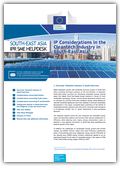 |
IP considerations for the cleantech industry in South-East Asia PDF 978-92-9202-504-5 10.2826/437803 EA-03-19-402-EN-N Paper 978-92-9202-503-8 10.2826/184388 EA-03-19-402-EN-C |
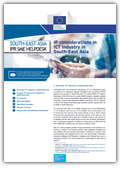 |
IP considerations in ICT industry in South-East Asia PDF 978-92-9202-505-2 10.2826/65821 EA-03-19-403-EN-N Paper 978-92-9202-506-9 10.2826/993982 EA-03-19-403-EN-C |
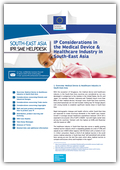 |
IP Considerations in the medical device & healthcare industry in South-East Asia PDF 978-92-9202-507-6 10.2826/352590 EA-03-19-404-EN-N Paper 978-92-9202-508-3 10.2826/482554 EA-03-19-404-EN-C |
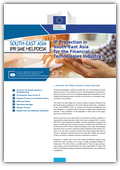 |
IP protection in South-East Asia for the financial technologies industry ‘Financial technologies’ (Fintech) describes the use of technology to provide financial services. This includes the use of new technologies to provide existing services such as the use of smartphone applications to provide access to banking and mobile payments, and also to new services, for example cryptocurrencies such as Bitcoin. PDF 978-92-9202-973-9 10.2826/623314 EA-01-20-334-EN-N Paper 978-92-9202-974-6 10.2826/370111 EA-01-20-334-EN-C |
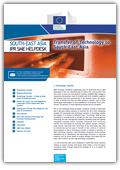 |
Transfer of technology to South-East Asia PDF 978-92-9202-509-0 10.2826/106448 EA-03-19-405-EN-N Paper 978-92-9202-510-6 10.2826/489324 EA-03-19-405-EN-C |
